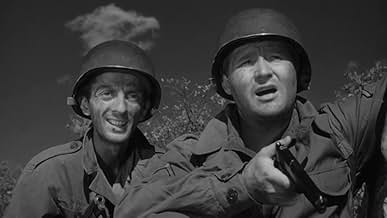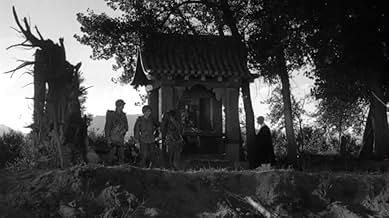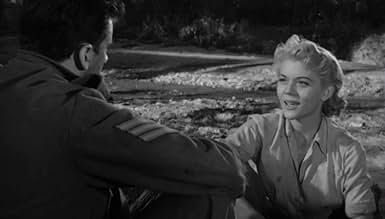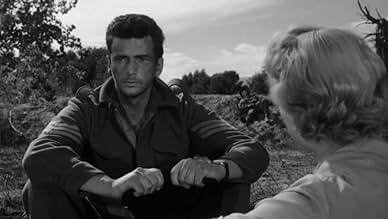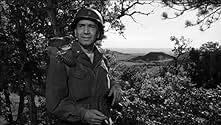Set during the Korean War, a unit of American soldiers, together with three British tank crew, find themselves trapped behind enemy lines.Set during the Korean War, a unit of American soldiers, together with three British tank crew, find themselves trapped behind enemy lines.Set during the Korean War, a unit of American soldiers, together with three British tank crew, find themselves trapped behind enemy lines.
- Director
- Writers
- Stars
John Anderson
- Undetermined Role
- (uncredited)
Joby Baker
- Private
- (uncredited)
George Chan
- Priest
- (uncredited)
Abel Fernandez
- Pvt. Geronimo
- (uncredited)
Ralph Lorraine
- Soldier
- (uncredited)
Strother Martin
- Pvt. Dan O'Hirons
- (uncredited)
Joseph Mosser
- Soldier
- (uncredited)
Don Oreck
- Pvt. Stacey Della Nueva
- (uncredited)
- Director
- Writers
- All cast & crew
- Production, box office & more at IMDbPro
Featured reviews
There have been some very good Korean War flicks..."Target Zero" really isn't one of them. Instead, the film is pretty dull...as well as ridiculous.
The film begins with a small band of American soldiers finding a hot blonde (Peggy Castle) as they try to get back to their unit. This part of the film really annoyed me, as the well-coiffed lady NEVER would have been in this situation and it seemed beyond just a bit contrived. Soon, they come upon a British tank and its crew and a bit later they come upon an American Lieutenant and some more men. Together, this rag-tag group of men...and a woman...need to fight their way back to safety.
This film seemed pretty dull and offered little in the way of excitement. It also had some silly dialog and never seemed the least bit credible or interesting.
The film begins with a small band of American soldiers finding a hot blonde (Peggy Castle) as they try to get back to their unit. This part of the film really annoyed me, as the well-coiffed lady NEVER would have been in this situation and it seemed beyond just a bit contrived. Soon, they come upon a British tank and its crew and a bit later they come upon an American Lieutenant and some more men. Together, this rag-tag group of men...and a woman...need to fight their way back to safety.
This film seemed pretty dull and offered little in the way of excitement. It also had some silly dialog and never seemed the least bit credible or interesting.
It's Korea 1952. The war has descended into a grinding morass. There are various soldiers and non-coms of the coalition trying to survive the unrelenting death machine. Ann Galloway's car gets blown off a ridge. She's picked up by a British tank crew driving an American Sherman. They encounter a squad of American soldiers led by Lt. Tom Flagler who aims to head for a hill which has been surrounded after the push by the Chinese.
The dialogue is stale and the actors don't always help. Peggie Castle is more notable for her perfect hair and beautiful face. She has an overly dramatic breakdown scene. Charles Bronson has a minor role but at least, he delivers his self-contained brute. The filming and the acting are all pretty flat. There is some real action with real machinery. It's not exciting due to its old filming techniques. Mowing down the enemy is done with the old style dying. It's all rather old fashion.
The dialogue is stale and the actors don't always help. Peggie Castle is more notable for her perfect hair and beautiful face. She has an overly dramatic breakdown scene. Charles Bronson has a minor role but at least, he delivers his self-contained brute. The filming and the acting are all pretty flat. There is some real action with real machinery. It's not exciting due to its old filming techniques. Mowing down the enemy is done with the old style dying. It's all rather old fashion.
Awfull script. Decent cast deliver performances well below their ability. Simply should not have been this bad a film....but it is.
Usually Leonard Maltin and I agree on movies....
Not this one. I have seen it perhaps four or five times. An American unit, sitting astride a strategic hilltop, plugging the Main Line of Resistance, is over-run and wiped out. Only a patrol and some stragglers picked up along the way are able to reach the now-undefended hilltop in time.
I found this story to ring true....with good characterizations and plot developments. Sure, the enemy is the two-dimensional Yellow Menace....that's standard with fifties-era movies.....but the mix of up-and-coming young actors is in itself worth the time to view this film.
A good story, well-acted, worthy of a look. And quite useful to someone trying to get a real look at war in Korea after the conflict settled into a stalemate. I recommend it.
Not this one. I have seen it perhaps four or five times. An American unit, sitting astride a strategic hilltop, plugging the Main Line of Resistance, is over-run and wiped out. Only a patrol and some stragglers picked up along the way are able to reach the now-undefended hilltop in time.
I found this story to ring true....with good characterizations and plot developments. Sure, the enemy is the two-dimensional Yellow Menace....that's standard with fifties-era movies.....but the mix of up-and-coming young actors is in itself worth the time to view this film.
A good story, well-acted, worthy of a look. And quite useful to someone trying to get a real look at war in Korea after the conflict settled into a stalemate. I recommend it.
If you're looking for a hard-hitting Korean War film made in the 1950s, something that illuminates the anguish, tension and hard command decisions made in the heat of battle, you'll do well to seek out Sam Fuller's THE STEEL HELMET (1951), Anthony Mann's MEN IN WAR (1957), and Lewis Milestone's PORK CHOP HILL (1959). Even Tay Garnett's ONE MINUTE TO ZERO (1952), starring Robert Mitchum, has its penetrating moments. If, on the other hand, you're looking for laughable dialogue and hoary clichés, then you're best left with Harmon Jones' TARGET ZERO (1955), about allied soldiers—and a woman—lost behind enemy lines and wandering rather aimlessly over a sunny American landscape doubling for Korea.
You can tell where the film is going right after the opening credits as a truck carrying two women, an attractive American blonde and an Asian woman in fatigues, is hit by North Korean mortar shells and goes crashing into a ravine. The blonde gets out, a little shaken and dazed but thoroughly unscathed, with hair and makeup intact, while the poor Asian woman is dead, having had about one line of dialogue and mere minutes after the actress's name (Angela Loo) appeared in the credits. The hot blonde is Annie Galloway, a "biochemist" with the United Nations health team, and she's played by Peggie Castle, a regular in westerns and Mickey Spillane adaptations of the era. She quickly hooks up with a straggling English tank crew led by a sergeant named David (Richard Stapley), all of whom are then joined by a lost American platoon seeking Easy Company. The Americans commandeer the tank to aid their search and recruit Annie to act as nurse to a wounded man (Strother Martin) whom they place on the back of the tank. After a few miles of this she complains that the bouncing of the tank in motion is hurting the wounded man, so they take him off and make one of the soldiers carry him on his back, as if that wouldn't hurt him even more! Even if that soldier happens to be Charles Bronson!
The ranking American officer, Lt. Tom Flagler (Richard Conte), soon starts putting the moves on Annie, making the uptight English sergeant very jealous indeed. Annie, in an unlikely turn of events, eventually responds to Flagler's rather crude charms. At one point, they're in a bunker and exchange this dialogue after a rather foreseeable tragic occurrence: Annie: "What's the matter with me, Tom? Why can't I cry?" Tom: "You've been at war, Annie. In here, death is like rain. Some days you have it. Some days you don't." Annie: "It's all so distorted. Nothing seems real or lasting." Tom: "We're real, Annie. You and me." That's what the script is like.
Unlike the Korean War movies cited in my first paragraph, no one here ever seems to take their situation seriously enough. There's a wisecracking southerner named Felix (L.Q. Jones) who jokes at every turn. There's an American Indian named Geronimo (Abel Fernandez) who tells Felix that the Indians joined the army so they can learn the white man's fighting skills and take America back from them. Later, Flagler approaches Geronimo as he's preparing to face down attacking "Reds" and asks him, "Whaddaya say, Injun?" Geronimo responds with "Now I know how Custer felt." It's that kind of film.
L.Q. Jones and Strother Martin both play members of the platoon and would later famously team up as the pair of scuzzy bounty hunters, T.C. and Coffer, in Sam Peckinpah's THE WILD BUNCH. Chuck Connors (TV's "The Rifleman") turns up as radioman Moose. Aaron Spelling, the future TV mastermind behind "Charlie's Angels," "Fantasy Island," and "Love Boat," shows up as "Strangler," one of those annoying, obsequious little sidekicks you often saw in war movies (and Warner Bros. cartoons). Charles Bronson is his usual earnest self. Richard Conte walks through his part with a casualness that's a pale echo of the studied unflappability he brought to his roles as infantry grunts in World War II movies such as GUADALCANAL DIARY and A WALK IN THE SUN ("Everybody dies").
The film was shot on the grounds of Fort Carson, a U.S. Army base in Colorado, and made use of the Colorado Air National Guard in the film's one impressive combat sequence, in which we see a team of four fighter jets attack the oncoming Reds as our heroes defend a hill called "Sullivan's Muscle." The jets do some stunning maneuvers and are seen in shots with the actors, including one startling bit where a jet appears from below and flies right over Conte's head. That must've required some heavy-duty persuasion.
In another comment here, the writer mentions "freezing winter conditions" and "the plight of civilians." The terrain presented here seems quite sunny and warm and if there were any scenes with civilians, they were completely absent from the print of this film that I saw.
You can tell where the film is going right after the opening credits as a truck carrying two women, an attractive American blonde and an Asian woman in fatigues, is hit by North Korean mortar shells and goes crashing into a ravine. The blonde gets out, a little shaken and dazed but thoroughly unscathed, with hair and makeup intact, while the poor Asian woman is dead, having had about one line of dialogue and mere minutes after the actress's name (Angela Loo) appeared in the credits. The hot blonde is Annie Galloway, a "biochemist" with the United Nations health team, and she's played by Peggie Castle, a regular in westerns and Mickey Spillane adaptations of the era. She quickly hooks up with a straggling English tank crew led by a sergeant named David (Richard Stapley), all of whom are then joined by a lost American platoon seeking Easy Company. The Americans commandeer the tank to aid their search and recruit Annie to act as nurse to a wounded man (Strother Martin) whom they place on the back of the tank. After a few miles of this she complains that the bouncing of the tank in motion is hurting the wounded man, so they take him off and make one of the soldiers carry him on his back, as if that wouldn't hurt him even more! Even if that soldier happens to be Charles Bronson!
The ranking American officer, Lt. Tom Flagler (Richard Conte), soon starts putting the moves on Annie, making the uptight English sergeant very jealous indeed. Annie, in an unlikely turn of events, eventually responds to Flagler's rather crude charms. At one point, they're in a bunker and exchange this dialogue after a rather foreseeable tragic occurrence: Annie: "What's the matter with me, Tom? Why can't I cry?" Tom: "You've been at war, Annie. In here, death is like rain. Some days you have it. Some days you don't." Annie: "It's all so distorted. Nothing seems real or lasting." Tom: "We're real, Annie. You and me." That's what the script is like.
Unlike the Korean War movies cited in my first paragraph, no one here ever seems to take their situation seriously enough. There's a wisecracking southerner named Felix (L.Q. Jones) who jokes at every turn. There's an American Indian named Geronimo (Abel Fernandez) who tells Felix that the Indians joined the army so they can learn the white man's fighting skills and take America back from them. Later, Flagler approaches Geronimo as he's preparing to face down attacking "Reds" and asks him, "Whaddaya say, Injun?" Geronimo responds with "Now I know how Custer felt." It's that kind of film.
L.Q. Jones and Strother Martin both play members of the platoon and would later famously team up as the pair of scuzzy bounty hunters, T.C. and Coffer, in Sam Peckinpah's THE WILD BUNCH. Chuck Connors (TV's "The Rifleman") turns up as radioman Moose. Aaron Spelling, the future TV mastermind behind "Charlie's Angels," "Fantasy Island," and "Love Boat," shows up as "Strangler," one of those annoying, obsequious little sidekicks you often saw in war movies (and Warner Bros. cartoons). Charles Bronson is his usual earnest self. Richard Conte walks through his part with a casualness that's a pale echo of the studied unflappability he brought to his roles as infantry grunts in World War II movies such as GUADALCANAL DIARY and A WALK IN THE SUN ("Everybody dies").
The film was shot on the grounds of Fort Carson, a U.S. Army base in Colorado, and made use of the Colorado Air National Guard in the film's one impressive combat sequence, in which we see a team of four fighter jets attack the oncoming Reds as our heroes defend a hill called "Sullivan's Muscle." The jets do some stunning maneuvers and are seen in shots with the actors, including one startling bit where a jet appears from below and flies right over Conte's head. That must've required some heavy-duty persuasion.
In another comment here, the writer mentions "freezing winter conditions" and "the plight of civilians." The terrain presented here seems quite sunny and warm and if there were any scenes with civilians, they were completely absent from the print of this film that I saw.
Did you know
- TriviaAccording to a contemporary article in The Hollywood Reporter, ordnancemen Royal Lowe, and Louis Farkas were killed, and truck driver Paul Zook was seriously injured after wrapping up location shooting near Colorado Springs when explosives being loaded onto a truck detonated.
- ConnectionsFeatured in Boulevard! A Hollywood Story (2021)
Details
- Release date
- Country of origin
- Language
- Also known as
- Sperrfeuer auf Quadrat 7
- Filming locations
- Production company
- See more company credits at IMDbPro
- Runtime1 hour 32 minutes
- Color
- Aspect ratio
- 1.37 : 1
Contribute to this page
Suggest an edit or add missing content


